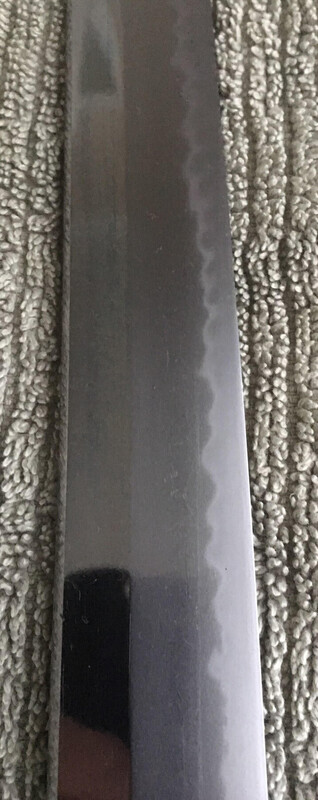-
Posts
1,901 -
Joined
-
Last visited
-
Days Won
85
Content Type
Profiles
Forums
Events
Store
Downloads
Gallery
Everything posted by IJASWORDS
-
Showa22 perpetuates the myth of the pilot/tank crew sword. These shorter swords are wakizashi's pressed into service during the time when the longer regular swords were in short supply. They are normally older blades, sold or donated, that have a leather combat cover placed over the wood saya. Some of these wakizashi's can be quite good old blades. If the pilot sword was a fact, then they would have been manufactured during the war for air crew. In fact waks made in WW2 are VERY RARE. These shorter swords were normally sold to officers with non-combat desk jobs, so length didn't matter. This is another reason that they are found in good condition, they were never used in combat.
-

Late model War Mounts 1944 Date
IJASWORDS replied to Swords's topic in General Nihonto Related Discussion
Steve, this sword in question is in fairly uncommon mounts. Being late war, the fittings are very basic, pressed metal, with no detail. If the blade is in good condition, it is a very collectable sword. I would also suggest that your posts are more appropriate to be posted in the MILITARY section. -

WW2 katana by yoshikane tuskuru Kore
IJASWORDS replied to Swords's topic in General Nihonto Related Discussion
Steve, Steve, Steve.... please read the posts a bit more carefully. I didn't use the term "cheap knockoff!!" I said knockout. This term describes a sword that was made in volume and with less care than a special order during the war. A cheap knockoff refers to a fake, WHICH YOURS IS NOT! All the answers you are looking for are in the replies from members far clever than I. Probably 90% of what you are asking is probably a click away on GOOGLE anyway, your learn more by doing your own research. And read a bit more attentively please. -

WW2 katana by yoshikane tuskuru Kore
IJASWORDS replied to Swords's topic in General Nihonto Related Discussion
Steve, how can you be sure your sword was traditionally made? Swordsmiths of this era, even highly ranked ones made various grades from "special orders" through to common or garden "knockouts" for the war. Forget about the signature or any competitions the swordsmith may have entered, it is about your INDIVIDUAL sword! If you are buying a sword, its all about the blade you are considering. A word of warning to the new collector, many WW2 swords, because they were souvenirs or bought relatively inexpensively, have been subject to "backyard" polishing, sharpening etc, and the original sword's geometry may be irretrievably damaged beyond restoration. So without a close examination in the hand, who knows if your sword is good or not. My advice, keep this one as is as a piece of militaria until you learn more about the subject. -

Arsenal Mark on RJT sword Fittings
IJASWORDS replied to george trotter's topic in Military Swords of Japan
The RJT smiths were an "approved" list of Army sword smiths. If these RJT smiths used the tamahagane and red pine charcoal supplied to them to make swords in the traditional way, those swords were given the 'star stamp'. These swords were inspected and entered the supply chain for distribution to officers. The star stamp being the guarantee of being traditionally made, using traditional materials, but not necessarily quality. Other swords could be made by an RJT swordsmith. These could be "knock-outs" or "special-orders" that did not use the tamahagane which needed to be accounted for by the RJT system, hence no star stamp. Other swords made in the traditional way, such as YASUKUNI and MINATOGAWA, did not receive star stamps as they used tamahagane from their own tatara, and did not use raw materials supplied under the RJT system. -

Arsenal Mark on RJT sword Fittings
IJASWORDS replied to george trotter's topic in Military Swords of Japan
NO NO NO, leave it up, its an important resource! -
Swords (Steve),.... Rich, George and David have provided you more than enough information on this topic. I take issue with one of your posts, saying that you and Rich are the only NAGAMITSU enthusiasts, I have a few, they are great swords to study, and if the post is in still in the for sale section, you can see a good example I just sold. As David says, they are GENDAITO. And judge the sword, not the signature. I would however ask you to take a close look at yours, from your photos the boring nature of your HAMON could be due to a post war polish and ACID treatment.
-
Bryce, you are correct, slip of the keyboard.
-
-
Wish I could take photos as good as Tom above, but here is my attempt. A 1936 GASSAN SADAKATSU, polished, papered, which shows the AYASUJI hada. The sword is dedicated to the birth of the Imperial Prince.
-
-
-
Thought I would put up a (OTA) YASUTSUGU, he is featured on page 194 in Slough. Although rated a Medium-High Grade Gendaito, he did make some really nice swords. The nice polish on this example, displays his skill in sword making.
-
WOW, thanks JP! I wonder if someone did polished photo micrographs of the grain structure?
-
There is no doubt that early Mantetsu swords exhibit HADA, fine grained it may be, but definitely there. I have some. Some of them even had wavy HAMON. The steel used in a Mantetsu sword was made in an electric furnace, not the traditional TATARA. An electric furnace is just another way of providing heat to the raw materials. As you all know, the iron/steel used in a sword made from TAMAHAGANE never melts, it is made into a sponge, full of impurities, and gases. Repeated heating, hammering and folding remove the un-wanted impurities. So one could assume that at least in the early production of Mantetsu, the metallurgists were trying to reproduce a TAMAHAGANE like material, or steel sponge in the electric furnace. Using the high-speed power machine tools of the time, this sponge could be quickly turned into a many times folded homogeneous piece of steel. This folded hot steel could then be hot sheared, and the center pierced into "hockey puck" like pieces or donuts. So, it is commonly assumed that the softer iron core was inserted into the outer skin steel, some liken it to a rod inserted into a pipe. The longer the pipe the greater the probability of voids and discontinuities exist on forge welding, so a shorter "pipe and rod" system would guarantee no forging faults. In the sword forging process, this billet would be drawn out and lengthened by repeated heating and hammering into the sword shape. It is feasible that the Mantetsu steel pucks were made in Manchuria and distributed to sword makers in many localities, like boxes of donuts, but with a core of soft iron. Getting some Mantetsu swords, cutting and sectioning them would confirm their production methodology. So in summary, you have to assume that the above method would lend itself to mass production, ease of production, and a consistent product. The very rough sketch below is an attempt to show how a shorter pipe and core would have many production, manufacturing and quality benefits over a long thin difficult to make pipe.
-
No idea, but I like it!
-

Arsenal Mark on RJT sword Fittings
IJASWORDS replied to george trotter's topic in Military Swords of Japan
-

Kai Gunto Type 98 - Worth pursuing?
IJASWORDS replied to Kaiser21's topic in Military Swords of Japan
YES, worth it! -
Here is a (Kajiwara) HIROMITSU. It is dated December 1943. It looks like it started its life as a special order Civilian mounted sword, and later, taken to war in a leather combat saya. It has no stamps. The fittings are a complete set of rare Showa Period pine tree motif in brass, and a blue/green ito wrap often seen on WW2 swords. The blade is in full polish. This famous smith was from Fukuoka, was responsible for some nice traditionally made swords.
-
You probably would guess that in my collection of Mantetsu swords, I would have a piece that may settle the controversy. I have what I think is one of the earliest examples made, a Winter 1938, when production commenced, (or end of 1938 as the records show). And as most of you know, I have an example of every year including 1945. This sword has a DEFINITE hada, fine it maybe, but very visible. My photography is poor, but there is enough hada to show it exists.
-

A word about amateur polishing
IJASWORDS replied to Brian's topic in General Nihonto Related Discussion
I bought all this equipment to polish old blades, now you tell me it's not appropriate? You sure know how to rain on a guys parade! (This should get me kicked off the forum for a while!). -

Anyone heard from Markus Sesko?
IJASWORDS replied to IJASWORDS's topic in General Nihonto Related Discussion
Markus, thankyou for your reply. I realize the enormity of task at hand. However with books by Kishida on Yasukuni, and Wallinga on Minatogawa, Slough on hundreds of Gendai smiths and the latest works of Malcolm Cox, a book covering those missing from these publications would be a great start. Most of us have these books already, or access to them. You could also put out a call for any missing oshigata that we could could supply from our collections. Hope this helps, and I am sure that the enormous burden you have undertaken could be somewhat relieved.




































